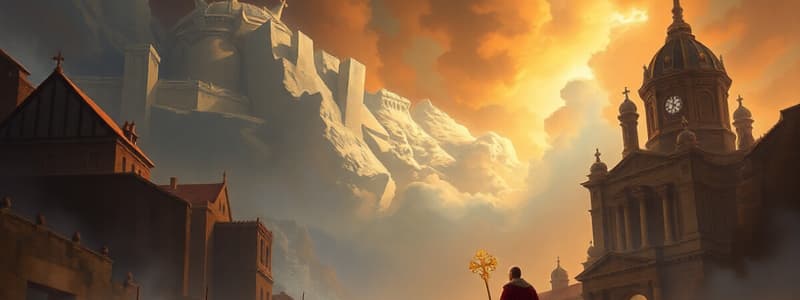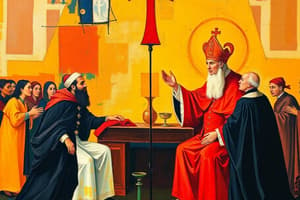Podcast
Questions and Answers
Which factor primarily fueled the East-West Schism between the Eastern Orthodox and Roman Catholic Churches?
Which factor primarily fueled the East-West Schism between the Eastern Orthodox and Roman Catholic Churches?
- Competition for land and resources in the newly discovered Americas.
- Disputes over the use of icons and religious imagery in worship practices.
- Conflicts over papal authority and differing theological emphases. (correct)
- Disagreements over the theological interpretation of the Holy Spirit's role in salvation.
How did theological focuses differ between the Eastern Orthodox and Roman Catholic Churches before the Schism?
How did theological focuses differ between the Eastern Orthodox and Roman Catholic Churches before the Schism?
- The Eastern Church emphasized the divinity of Jesus, while the Western Church emphasized the humanity of Jesus. (correct)
- The Eastern Church focused on practical applications of faith, while the Western Church emphasized mystical experiences.
- Both churches had identical theological focuses, but differed in their liturgical practices.
- The Eastern Church emphasized the humanity of Jesus, while the Western Church emphasized the divinity of Jesus.
Which statement accurately describes the linguistic practices of the Eastern Orthodox and Roman Catholic Churches before the Schism?
Which statement accurately describes the linguistic practices of the Eastern Orthodox and Roman Catholic Churches before the Schism?
- The Eastern Church primarily used Greek, while the Western Church primarily used Latin. (correct)
- The Eastern Church primarily used Latin, while the Western Church primarily used Hebrew.
- Both churches primarily used Latin, but the Eastern Church also incorporated Greek for local congregations.
- Both churches conducted services exclusively in Greek to maintain theological purity.
What role did political distrust play between Eastern and Western Church leaders leading up to the Great Schism?
What role did political distrust play between Eastern and Western Church leaders leading up to the Great Schism?
How did wealth distribution contribute to the weakening of the Roman Empire during the fourth century?
How did wealth distribution contribute to the weakening of the Roman Empire during the fourth century?
Which factor most directly undermined the Roman Empire's ability to effectively defend against external invasions during its decline?
Which factor most directly undermined the Roman Empire's ability to effectively defend against external invasions during its decline?
Although multiple disagreements contributed to the Great Schism of 1054, which issue fundamentally challenged the hierarchical structure and authority within the Christian Church?
Although multiple disagreements contributed to the Great Schism of 1054, which issue fundamentally challenged the hierarchical structure and authority within the Christian Church?
Constantine's decision to declare toleration for Christianity in 313 CE and later establish it as the state religion had numerous consequences. Which of the following was a less immediate but significant long-term societal impact of this shift?
Constantine's decision to declare toleration for Christianity in 313 CE and later establish it as the state religion had numerous consequences. Which of the following was a less immediate but significant long-term societal impact of this shift?
Following the Great Schism of 1054, several attempts were made to reunite the Eastern and Western churches. Which event most decisively undermined these reunification efforts and deepened the divide between the two branches of Christianity?
Following the Great Schism of 1054, several attempts were made to reunite the Eastern and Western churches. Which event most decisively undermined these reunification efforts and deepened the divide between the two branches of Christianity?
After the division of the Roman Empire, a key difference emerged in the governance of the Church in the Eastern and Western halves. Which of the following best describes a distinction in church administration that developed primarily in the Eastern Church?
After the division of the Roman Empire, a key difference emerged in the governance of the Church in the Eastern and Western halves. Which of the following best describes a distinction in church administration that developed primarily in the Eastern Church?
Flashcards
The Great Schism
The Great Schism
The split of medieval Christianity into the Eastern Orthodox and Roman Catholic Churches in 1054.
Causes of the Schism
Causes of the Schism
Religious and political disagreements, including differing theologies and authority disputes.
Eastern Orthodox Characteristics
Eastern Orthodox Characteristics
Occupied Asia Minor, the Middle East, and North Africa; focused on the divinity of Jesus Christ.
Roman Catholic Characteristics
Roman Catholic Characteristics
Signup and view all the flashcards
Problems of the Roman Empire
Problems of the Roman Empire
Signup and view all the flashcards
Elite Retreat Impact
Elite Retreat Impact
Signup and view all the flashcards
Military Decline in Rome
Military Decline in Rome
Signup and view all the flashcards
Constantine's Impact
Constantine's Impact
Signup and view all the flashcards
Fourth Crusade's Impact
Fourth Crusade's Impact
Signup and view all the flashcards
Study Notes
- The Eastern Orthodox Church and Roman Catholic Church split in 1054, known as the Great Schism or East-West Schism.
- Religious and political disagreements caused the Schism, including geography, miscommunication, differing theologies, and politics.
- Disagreements centered on who had ultimate authority, which language to use for services, and other issues.
Eastern Orthodox Christianity
- Occupied Asia Minor, the Middle East, and North Africa.
- Used Greek with little to no Latin tradition.
- Theology focused on the divinity of Jesus Christ.
- Michael Cerularius, the Patriarch of Constantinople, distrusted the Pope and accused Western traditions of being un-Christian.
Roman Catholic Church
- Encompassed Western Europe and the northern and western Mediterranean.
- Relied on Latin and Roman tradition, with little to no Greek.
- Theology emphasized the humanity of Jesus Christ, using realistic iconography.
- Pope St. Leo IX believed Eastern Church leaders were political puppets of the Byzantine empire.
Political Factors: Western Roman Empire vs. Eastern Roman Empire
- Economic, social, and political issues crippled the Roman Empire in the fourth century.
- The Empire split into the Western Roman Empire and Eastern Roman Empire after lasting about 1000 years.
- The wealthiest 1% controlled over 16% of the Empire's wealth, leading to destabilization as elites retreated from positions of power.
- Economic security depended on expansion, militarism, and the spoils of war, but wealth and labor were not shared amongst the middle and lower classes due to the elites.
- The Roman military faced poor funding, few recruits, and increasing invasions.
- Northern European tribes threatened the Empire, and declining morale coupled with poor funding weakened the military resulted in Rome being unable to protect its citizens from outside invasions.
- Emperor Constantine's leadership weakened belief in Roman traditions.
- In 313 CE, Constantine declared toleration for Christianity, which later became the state religion and undermined traditional Roman religious practices.
- In 330 CE, Constantine divided the Roman Empire into the Western and Eastern Roman Empires.
- The East was centered around Constantinople, and the West was centered around Rome.
- When the Roman Empire fell, the East became the Byzantine Empire, and the West became politically dependent on the church.
- Christianity remained united across the East and West during this time.
- The Byzantine Emperor appointed priests in the East, and the Eastern half was wealthier than the West.
Ecclesiastical and Regional Factors: Eastern Churches vs. Western Churches
- In 1054, the Christian Church split into the Eastern Orthodox and Roman Catholic churches.
- The Great Schism occurred when Michael Cerularius, the Patriarch of Constantinople, was excommunicated.
- The Great Schism resulted from religious and political reasons between the Orthodox and Catholic churches, including language disputes, church organization, and differing religious practices.
- They disagreed on using unleavened bread for communion.
- Disputes included whether sermons had to be in Latin or if Greek was appropriate.
- The Western church believed the Pope should have authority over the Eastern Patriarch; each church recognizing their own leaders.
- The Western church excommunicated Cerularius, and the Eastern church excommunicated the Roman Pope.
Major Events Following the Schism of 1054
- The churches remained on friendly terms until 1204 but have never reunited.
- In 1204, the Fourth Crusade ended friendly communication when Crusaders sacked wealth from Constantinople.
- The Fourth Crusade led to the end of the Byzantine Empire and strengthened the divide.
- In 1274, the Second Council of Lyon was held to reunite the East and West, but the Orthodox clergy did not accept the reunification.
- The Council of Ferrara-Florence (1438-1445) attempted reunification with a decree on doctrinal differences but ended shortly after.
- In 1453, Constantinople collapsed after a period of disarray which brought the end to reunification attempts.
- The First Vatican Council in 1870 solidified the Pope's power in the West.
Major Differences in the Orthodox vs. Catholic Churches
- Primary theological difference: the Holy Spirit proceeds from God the Father to Jesus Christ the Son (Catholic) vs. from God the Father alone (Orthodox).
- The Catholic Church believes the Pope has supreme authority, while the Orthodox Church has no doctrinal authority.
- The Orthodox Church allows for divorce, while the Catholic Church does not.
Eastern Orthodox vs. Roman Catholic: Papal Primacy
- The Catholic Church believes the Pope heads the Catholic Church and that Papal Primacy gives the Pope the authority to govern.
- The Orthodox Church recognizes the bishop of Rome to have a primacy in honor, but they do not believe he has primacy in jurisdiction.
- In 2007, the Declaration of Ravenna asserted that the Pope is the first among the Christian patriarchs but did not clarify governance.
Eastern Orthodox vs. Roman Catholic: The Filioque Clause
- Both churches believe that the Nicene Creed is foundational.
- Churches disagree on the Filioque Clause, where filioque is a Latin term that means "and the son".
- The Orthodox Church does not recite the Filioque Clause, while the Catholic Church does.
Similarities Between Roman Catholic and Eastern Orthodox Churches
- The churches hold meetings called Ecumenical Councils to develop ideology and doctrine.
- Both churches accept the results from the first seven councils.
- The First Council of Nicaea (325 CE) clarified the time of celebrating Easter and the Nicene Creed.
- The First Council of Constantinople (381 CE) made additions to the Nicene Creed declaring that the Holy Spirit proceeded from both God the Father and Jesus Christ the Son.
- The Council of Ephesus (431 CE) defined Catholic dogma and recognized the Virgin Mary as the Blessed Mother of God.
- The Council of Chalcedon (451 CE) affirmed that Jesus Christ was equal parts human and divine.
- The Second Council of Constantinople (553 CE) reaffirmed the dogmas stated by the third and fourth councils.
- The Third Council of Constantinople (680 CE) defined that Jesus has two wills.
- The Second Council of Nicaea (757 CE) defined veneration to holy images as honor being given to those they represent.
Studying That Suits You
Use AI to generate personalized quizzes and flashcards to suit your learning preferences.





